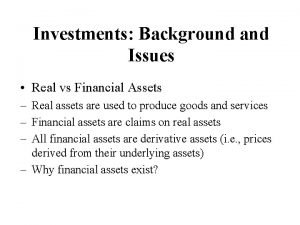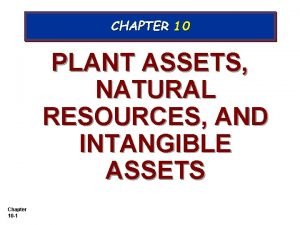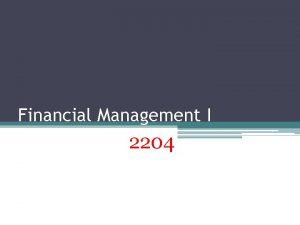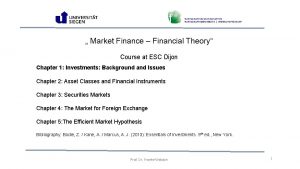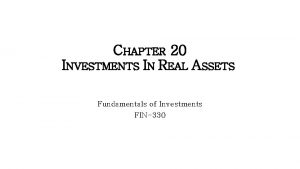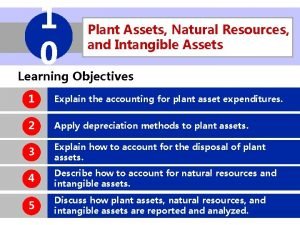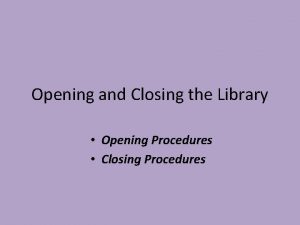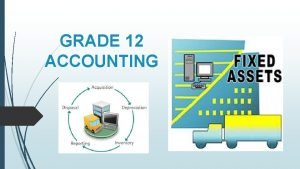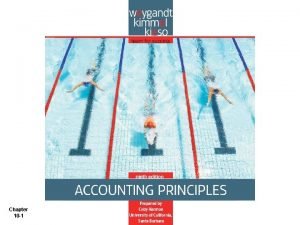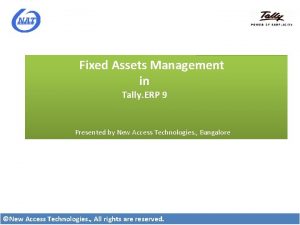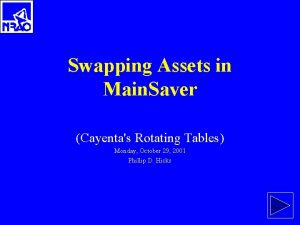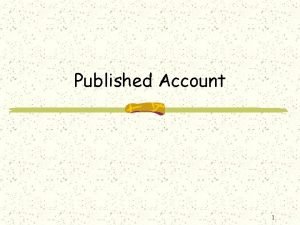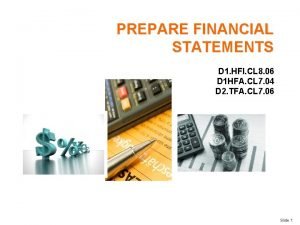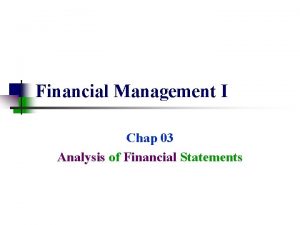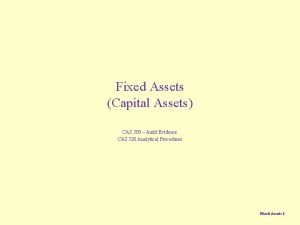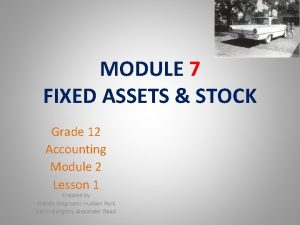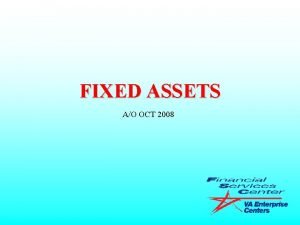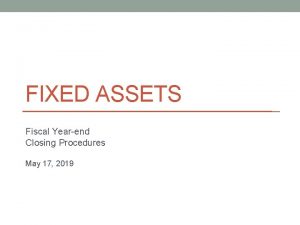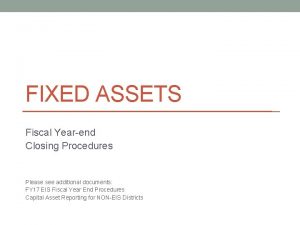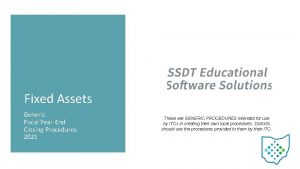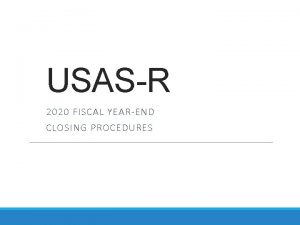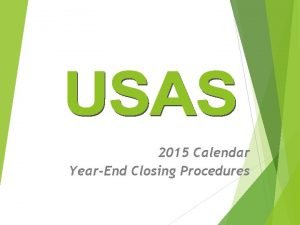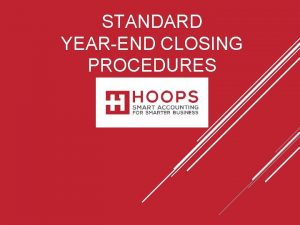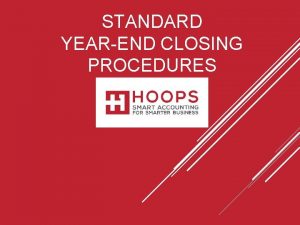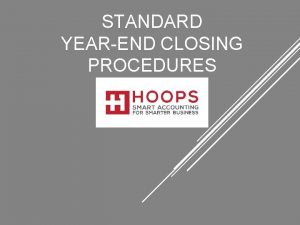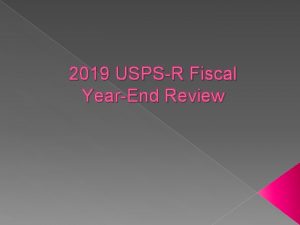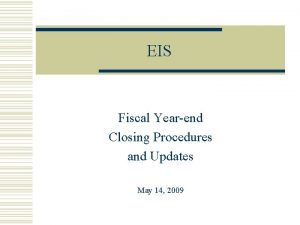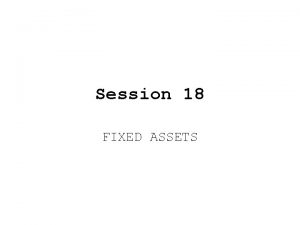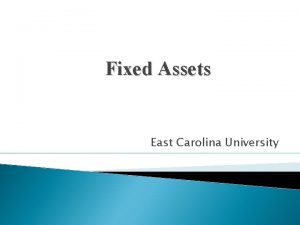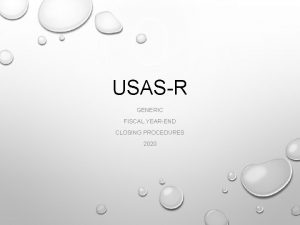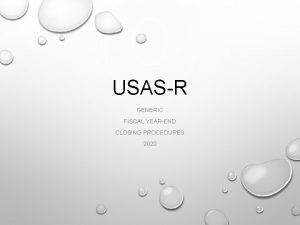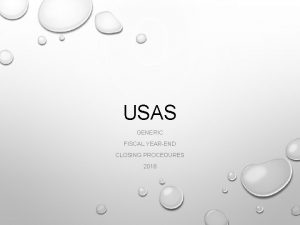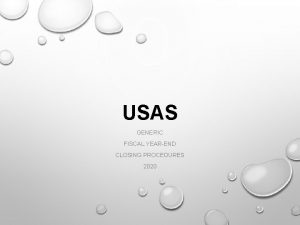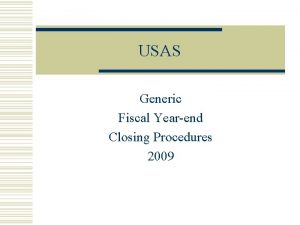FIXED ASSETS Fiscal Yearend Closing Procedures May 8



















- Slides: 19

FIXED ASSETS Fiscal Year-end Closing Procedures May 8, 2020

2 Disclaimer • These are generic procedures intended for use by ITC’s in creating their own local procedures. Districts should use the procedures provided to them by their ITC.

3 Capital Assets Reporting Changes

4 EIS Fiscal Year-End Closing Procedure • Finish all current year processing. • Items received on or prior to June 30 th, 2020 should be added to EIS for FY 2020. • Items received after June 30 th should added to the EIS pending file for FY 2021. • If depreciation data has been changed on several items so much that it’s necessary to completely recalculate the life-to-date (LTD) depreciation, you may run EISDEPR. • NOTE: Running EISDEPR will affect items that have had improvements (additional ACQTRNs throughout life of item) causing items to lose their true depreciation history.

5 EIS Fiscal Year-End Closing Procedure • Districts with a $ and Life Limit in DATSCN may run an EIS 304 Brief Asset Listing to verify all items meeting both the dollar and life capitalization threshold are capitalized. How? • In EIS 304, select: • non-capitalized items • select items with an original cost equal or higher than the capitalization threshold. • Generates report of items currently not capitalized but exceed the $ threshold. Check each tag to verify the life expectancy is under the life limit threshold and therefore should not be capitalized.

6 Fiscal Year-End Closing Procedure • When all items have been entered for the FY, district can run the recommended list of reports (this includes all necessary GAAP schedules). • All recommended FYE reports are explained in the upcoming slides. • NOTE: EISCD will generate most of these reports

7 Fiscal Year-End Closing Procedure • EIS 101 – Schedule of Fixed Assets by Source…. . summary of the original cost of capitalized items by their source (or fund) the items were charged to on PO. • Source means “the fund the items were originally charged to when purchased”. EIS 101 uses the PO information from the acquisition record (ACQTRN) to identify the source fund used in purchasing the items. • Output file: EIS 101. TXT • EIS 102 – Schedule of Fixed Assets by Function and Class…. schedule of fixed assets by function and class. Can be generated by function and class, class or a summary by function and class. Creates summary and detail reports. • The Book Value on the report is the Original Cost minus the Total Depreciation • Output files: EIS 102 S. TXT and EIS 102 D. TXT

8 EIS 103 • Contains “changes” in capital asset balances during the current FY • Creates three reports as listed below: • EIS 103 S is a summary report listing the beginning balance, acquisitions, dispositions, transfers in/out, adjustments and the ending balance in column format. • EIS 103 D is a detailed schedule of changes listing individual tags that make up the acquisitions, dispositions, transfers, or adjustments amounts. • EIS 103 E is an error report. • The summary and detail reports will page break on each fund type: fiduciary, governmental, proprietary, and undefined. • The GAAP flag must be set to “Y” to be able to generate this report. • For FYE, it is recommend to generate the report 3 different ways (AC, FC & FD). EISCD includes the 3 different ways. • Specific entity_IDs can be included or excluded (i. e. NOGAAP)

9 EIS 103 + - + =

10 EIS GAAP Reports • Totals by Fund Type on the EIS 101, EIS 102, and EIS 103 should match when balancing out for the fiscal year-end. • Any errors reported on the EIS 103 E report should be resolved prior to closing the fiscal year.

11 EIS 104 • Contains changes in depreciation of fixed assets during the fiscal year • The EIS 104 creates two reports as listed below: • EIS 104 S is a summary report listing the beginning depreciation, continuing items, acquisitions, dispositions, transfers, adjustments and ending depreciation balance in column format. • EIS 104 D is a detailed schedule of changes listing individual tags that make up the acquisitions, dispositions, transfers or adjustments amounts. • Reports will page break on each fund type: fiduciary, governmental, proprietary and undefined • The GAAP flag must be set to “Y” in order to generate a valid report. • For FYE, it is recommended to generate the report 3 different ways (AC, FC & FD); EISCD includes the 3 different ways • May be used as a depreciation balancing tool with the EIS 305.


13 Suggested Non-GAAP Reports • EIS 303 – Inventory Master Listing…. . includes all data on file for items; VERY LARGE report – it can produce a complete listing of all items or specified subsets (i. e. report of just depreciation information); don’t recommend printing out a hard copy of the report. • EIS 304 – Brief Asset Listing…. . a one line per item listing of all items on file or subsets; EIS 304 reports recommended to run at FYE…include capitalized items only and Status Codes of “A, N, EH, and EN” (with the exception of the disposition report). • Brief Asset Listing by fund EISCD • Brief Asset Listing by function includes • Brief Asset Listing by asset class all the • Acquisitions for current fiscal year • Dispositions for current fiscal year following

14 Suggested Non-GAAP Reports • EIS 305 – Book Value (Depreciation) Report…. . displays depreciation information listing original cost, salvage value, book value, % of depreciation, and last year of useful life. • The date 06/xxxx (where xxxx is FY being closed) is used for the reporting date. EIS 305 reports recommended to run at FYE…include capitalized items only and Status Codes of “A, N, EH, and EN” (with the exception of the disposition report). EISCD • Book Value Report by function • Book Value Report by class includes • Depreciation for current FY dispositions by function all the • Depreciation for current FY dispositions by class following

15 Suggested Non-GAAP Reports • EIS 401 – Insurance Values Report…. . lists insurable values and replacement cost information for items; insurable values listed reflect the insurance classifications assigned to the item categories in EISMNT/CATSCN; Recommended if the district maintains current replacement cost and/or insurable values on the inventory item records. • EIS 801 – Audit Report…. . tracks changes made to the EIS files • For FYE, select the Official Option and keep on file for the auditors… used as an official audit trail

16 Fiscal Year-End Closing Procedure • Run EISCD to generate a standardized set of FYE EIS reports. For more information and a listing of the reports generated, please refer to the EISCD chapter in the EIS Reference Manual. • Make a copy of their EIS data files; include USAS-related files • Includes EIS*. IDX, EISDAT. REL, EISAUD. SEQ, EISEMS. SEQ • Includes ACCT. IDX, INAMT. IDX, POHIST. IDX, TABL. IDX & VENDOR. IDX

17 Fiscal Year-End Closing Procedure • Run EISCLS • Creates EISCLS. TXT which includes ending balances by Fund, Function • • and Asset Class. (These are the beginning balances for the next year) Creates EISDEP. TXT which is a summary report of the current year’s depreciation, posted by fund. Advances EIS last FY closed flag in EISMNT/DATSCN by one year Adds one year’s worth of depreciation to LTD depreciation field Updates beginning balance fields for new FY • Once EISCLS is complete, they may start entering inventory for the new fiscal year.

18 Fiscal Year-End Closing Procedure • If EIS GAAP flag is not turned on, ITC needs to assist in helping the district start up on GAAP by running EISGAAP. • EISGAAP: run only once and at the beginning of the GAAP startup year. • Sets GAAP flag in EISMNT/DATSCN to “Y” • Creates beginning information fields for each asset (EISITM. IDX) • Generates a beginning balance report for the GAAP startup year • Once EISGAAP is complete, they may start entering inventory for the new fiscal year.

19 Questions?
 Plant assets, natural resources, and intangible assets
Plant assets, natural resources, and intangible assets Real vs financial assets
Real vs financial assets Plant assets natural resources and intangible assets
Plant assets natural resources and intangible assets Real assets vs financial assets
Real assets vs financial assets Lanni products is a start up computer
Lanni products is a start up computer Types of real assets
Types of real assets Plant assets, natural resources, and intangible assets
Plant assets, natural resources, and intangible assets Bar opening and closing procedures
Bar opening and closing procedures Fixed asset note grade 10
Fixed asset note grade 10 Useful life of property plant and equipment
Useful life of property plant and equipment Long-term assets
Long-term assets How are disposals of plant assets accounted for
How are disposals of plant assets accounted for Fixed assets in tally
Fixed assets in tally Cayenta fixed assets
Cayenta fixed assets Non fixed assets examples
Non fixed assets examples Fixed assets examples
Fixed assets examples Fixed assets turnover formula
Fixed assets turnover formula Audit evidence for fixed assets
Audit evidence for fixed assets New era accounting grade 10 memo pdf module 5
New era accounting grade 10 memo pdf module 5 Fixed assets schedule
Fixed assets schedule

